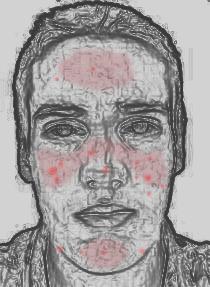A new preliminary study shows promise for one type of antibiotic called Zithromax (azithromycin) in the treatment of people with acne rosacea. This common skin condition, which causes a persistent facial blush and acne-like bumps, is notoriously resistant to effective treatment. Antibiotics, either topically or orally, have been the standard for years, but this treatment does not work for everyone. Results of a new pilot study were announced at the Fifth International Conference on the Macrolides, Azalides, Streptogramins, Ketolides and Oxazolidinones by Dr. Adolfo Fernandez-Obregon of the Hudson Dermatology and Skin Cancer Center in Hoboken, New Jersey.
The ten study participants, aged 32 to 76 years, had been previously and unsuccessfully treated with antibiotics. They either wanted to try another type of oral antibiotic or their skin was too sensitive for a topical version. They were told to take a single dose of 250 mg Zithromax three times a week. All were instructed to wash the affected skin with an over-the-counter soap-free cleanser. Dr. Fernandez-Obregon reported that all the participants showed a moderate to marked improvement in their condition within four weeks.
It is noteworthy that Dr. Fernandez-Obregon said that his results point to the need for clinical trials to determine the long-term efficacy and tolerability of Zithromax. No antibiotics/rosacea studies have lasted more than a few months; participants are not followed long enough to know whether the condition returns unchanged once antibiotics are stopped. Life-long antibiotic therapy clearly presents more health risks than the skin condition itself. Moreover, most of the studies, like this one, have only a small number of participants. Some doctors tell their patients that antibiotic therapy will prevent worsening of the condition, but only a well-designed long-term clinical trial will prove this contention.
At its most extreme, rosacea can cause enlargement of certain blood vessels in the face and/or the red, bulbous nose that distinguished W.C. Fields. Though rosacea mostly affects women, especially those who are fair-skinned and blush easily, its most detrimental cosmetic damage, the bulbous nose, is most likely to occur in men. It is a chronic and progressive condition with frequent remissions and flare-ups, which makes treatment effectiveness all the more difficult to assess in trials that last only a few months. Since antibiotics are not a cure, people with rosacea should first try avoiding conditions that precipitate facial reddening. The triggers are individual and can include spicy foods, hot or cold environments, stress, menopausal hot flushes, sun, wind, chocolate, tomatoes, and citrus fruits.
More Information:
For a free newsletter from the National Rosacea Society, call the toll-free number (888) 662-5874. The newsletter is supported by a grant from Galderma Laboratories, Inc., which makes a soap-free cleansing product. Back issues of the newsletter can be read on-line at their Web site (www.rosacea.org).
COPYRIGHT 2000 Center for Medical Consumers, Inc.
COPYRIGHT 2001 Gale Group



